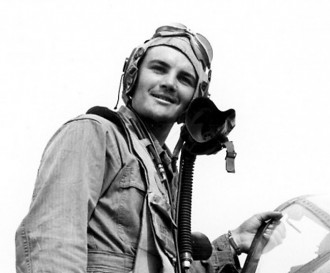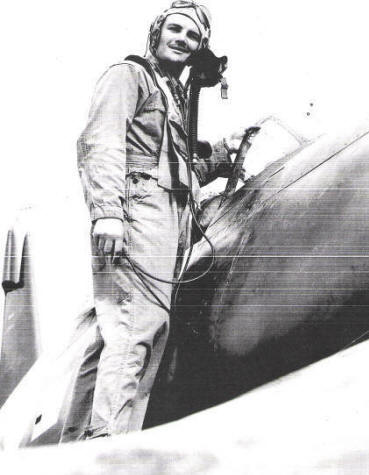Lake Michigan Flight Mystery
B.H. War Ace Disappears
Monday, August 5, 1946
Lost After Takeoff Sunday morning From Glenview Navy Base
Hope dimmed this afternoon for the survival of Lt. William L. Hood, Benton Harbor Marine ace gone missing since 8:30am yesterday on a flight from Glenview Naval Air Station to the Twin City Airport
Half a hundred Navy Planes, and half dozen civilian planes from the Twin City Airport and Coast Guard boats from three western Lake Michigan Coast Guard stations, completed a 24-hour continuous search for the missing airman shortly after noon today. The search is still continuing.
Lt. Hood took off from the Glenview naval air station, near Chicago, yesterday morning with clearance for the local airport. No trace has been found of the Benton Harbor pilot or his plane since. Lt. Hood is married. He is the son of Mrs. John Hood, 731 Superior.
The search got underway late yesterday afternoon when the young flyer was long overdue on the usual 40 minute flight across the lake. Four planes of the Twin Cities Flying Service piloted by Bert Grau, J.P.”Porky” Harvey, Don Manley and Del Tabor scanned southern Lake Michigan waters to not avail until nightfall prevented further flying.
KEEP UP SEARCH FOR LOST FLYER
Cling To Hope That Lt. Hood Is Alive
Tuesday August 6, 1946
Navy search planes will continue for at least another two days to comb the southern half of Lake Michigan for a trace of Lt. William L. Hood, Benton Harbor Marine ace, missing on a flight over the lake since 8:30 Sunday morning. It was disclosed to The News-Palladium by Captain Joseph M. Carson, USN, Commanding officer of the Glenview, Ill. Naval air station. Capt. Carson told The News-Palladium this morning that almost “every square foot of the southern half of the lake has been covered by Navy Planes and Coast Guard and Navy surface craft in the hunt for Lt. Hood”
“So far no trace of Lt. Hood or his plane has been found,” The captain said, “although we have not yet given up hope.”
Captain Carson said that the Coast Guard today discontinued its part in the search. He said, however, that the Great Lakes naval station might continue to send out surface craft.
THE CAPTAIN ADVANCED THE THEORY that Lt. Hood may have been picked up by an ore carrier going north and unable to communicate with shore stations. He said there is also a slim possibility that the missing ace may have reached the lake shore in some deserted spot.
Two Marine flyers, both of whom were squadron mates of Lt. Hood in the Pacific during the war, arrived in the twin cities last evening and took up the search early today in a twin-engined private plane.
The flyers are lieutenants Byron Beswick and Thomas Blackwell. They are flying a Cessna aircraft owned by the National Electric Corporation and stations at Ross field. Lt. Beswick told reporters here that he accompanied Hood from Oklahoma City to Glenview in the private plane in which Hood disappeared immediately prior to Hood’s take off from the Glenview airport Sunday morning.
The two lieutenants flew two Navy planes to Oklahoma City, where Hood purchased the private plane. They then took off for the return trip to Glenview.
Beswick said that engine trouble forced them down at Quincy Ind., about 200 miles south west of Chicago. After repairs to the engine, they flew on to Glenview. Beswick said Hood then took off for Benton Harbor alone. Beswick last saw him heading for the lake.
Beswick said that he blames himself for not having insisted that the engine of Hood’s plane be given an entire overhaul before Hood took off over the lake.
Captain Carson today emphasized that no effort would be spared in the search form Hood. He said that he himself had participated in the patrols, which are being made by patrol planes, slow trainers and twin-engined transports.
Searcher have concentrated on the direct route between Glenview and Benton Harbor and on the route from Milwaukee across the lake, just north of Benton Harbor, he said, adding that the shore line as well as the lake itself had been covered “foot by foot.” Twins city yachtsmen and private plane owners, who spent many hours Sunday and Monday aiding in the search today had all but given up their efforts.
PLANE REPORTED SEEN IN TROUBLE OVER SAND DUNES
Belated Story Told by Fisherman Brings Hunt near Bridgman
Wednesday, August 7, 1946
Search for Lt. William L. Hood, missing Benton Harbor pilot, turned to two new areas today-some 72 hours after the Marine ace disappeared in a light training plane on a flight from the Glenview naval air base north of Chicago en route to the twin city airport.
A posse of more than 60 persons, headed by Sheriff Erwin Kubath and four deputies, combed the densely wooded dunes area north of Waco beach, near Bridgman today after three fishermen belatedly reported seeing a sow flying plane, seemingly in distress, disappear in that area between 9 and 10 o’clock Sunday morning. The area was scanned early today by low flying search planes who reported no success after more that three hours of patrols.
Meanwhile, a NAVY PBY “CATALINA” AMPHIBIAN SEARCHED THE WATERS NORTH OF South Haven today after wreckage, believed to be that of the missing plane, was sighted from the air yesterday by the two Marine pilot buddies of Lt. Hood, Lieutenants Byron Beswick and Thomas Blackwell.
The two Marine officers undertook a private search yesterday and found what appeared to be airplane wreckage 16 miles north and west of South Haven harbor. Coast Guard boats were ordered to the scene yesterday afternoon, but due to fog and haze failed to find it.
The “Catalina” landed at the Twin City Airport, shortly after down this morning and took off at 10:30 a.m. to cover the area thoroughly.
Included in the posse combed the Waco beach area are a sister, brother-in-law and other relatives of the lost Marine ace. The searchers were spaced 40 to 60 yards apart, and are tramping north from Waco beach as far as Stevensville, a seven mile strip.
The plane, flying a southwesterly course, was sighted by the three fishermen at the approximate time Lt. Hood would have reached the area after taking off from Glenview. The plane was flying just off the water and its motor appeared to be missing. It disappeared over the dunes and was not reported until members of the fishing party read of the lost plane and its pilot.
Three planes from the Twin Cities Flying Service under the direction of Burt and Chet Grau, flew back and forth over the area for more than three hours this morning, but failed to sight any plane wreckage or broken timber which might have resulted form a plane crashing into tree underbrush.
On April 21, 1945 Lt. Hood bagged three Japanese fighter planes and shared in the kill of another. Seven days later he shot down two more Jap planes to achieve rating as an Ace. His missions included combat patrols, bombing and strafing in support of ground troops and rocket direction.
Lt. Hood returned to the United States just a year ago for leave and reassignment. At the expiration of his leave he was ordered to the Glenview base.
At the time of the supposed crash, Lt. Hood was flying his own plane, recently purchased at Oklahoma City. Okla. He had flown a fellow officer back to Glenview on Saturday and was bringing his plane to the Twin City airport when he became lost.
Navel search planes took to the air this morning to comb the waves for the missing ace and were joined by the four local pilots as well as the coast boats.
The plane Lt. Hoodwas flying was a Navy training plane. A Stearman PT-17, used by the Navy extensively for pilot training during the war. It is a land plane and is not equipped with life rafts or other life saving equipment.
However, it is extremely buoyant and authorities at the local airport say that the plane would remain afloat indefinitely if not broken up in an emergency water landing.

DISCONTINUE SEARCH FOR LT. WM. HOOD
Thursday, August 8, 1946
Twin city airmen and service pilots will make what will probably be the final search today for Lt. William L. Hood, Benton Harbor Marine ace missing since Sunday on a flight from Glenview naval air station to the twin cities airport.
Early this morning civilian planes again combed the Grand Mere swamp area in the search of wreckage or broken trees indicative of a crash landing. Sheriff’s men and Boy Scouts stood by to enter the rugged terrain on foot if the search planes discovered anything.
Late yesterday afternoon another group of planes scoured a wide area along Hickory Creek after a farmer reported his son had seen a yellow bi-plane of the type Lt. Hood was flying climbing over the trees Sunday morning. No trace of the missing plane was found.
The large posse that Sheriff Erwin Kubath led through the brush and woodland from Waco beach to Grand Mere after a fisherman also reported seeing a plane in trouble Sunday also was unsuccessful.
The Stearman PT-17 was built by the Stearman Aircraft Company of Wichita, Kansas, which was acquired by Boeing in 1934. The wings were constructed of wood frames covered in fabric. The fuselage had a tough, welded steel framework, also fabric covered.
The plane featured a fixed tail wheel undercarriage, and overall construction of the aircraft was considered rugged. The Stearman could carry two, in dual tandem cockpits. A five cylinder Continental R-670 radial engine powered most models, with a top speed of 124 mph and a range of 505 miles.
The plane is easy to fly, and relatively forgiving of new pilots. It gained a reputation as a rugged airplane and a good teacher. Over 10,000 of these aircraft were manufactured, and many were sold as surplus after WWII. Many became crop dusters and sport planes. Currently, over 1000 Stearmans are still airworthy.
The Boeing Stearman had a wingspan of 32 feet, a height of 9 feet, and a length of 24 feet. The ceiling of this aircraft is 11,200 feet, and it has a maximum takeoff weight of 2,717 lbs.



